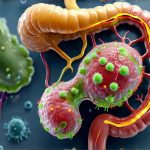The intricate connection between our gut microbiome – the vast community of microorganisms residing in our digestive tract – and systemic health is rapidly becoming one of the most exciting areas of modern research. For decades, we’ve largely viewed inflammation and autoimmune conditions as localized issues, often focusing on specific joints or organ systems. However, emerging evidence strongly suggests that the composition and function of our gut microbiota play a surprisingly significant role in modulating immune responses and influencing the development and progression of chronic inflammatory diseases like rheumatoid arthritis, psoriatic arthritis, and even broader musculoskeletal pain syndromes. Understanding this ‘gut-joint axis’ isn’t just about identifying new treatment targets; it’s about recognizing the profound interconnectedness of our bodies and embracing a more holistic approach to health.
The gut is far from simply a digestive organ; it’s now understood as a central command center for immune regulation. Approximately 70-80% of our immune system resides within the gut, constantly interacting with the microbial ecosystem. This constant interaction ‘trains’ the immune system to distinguish between harmless and harmful entities. A diverse and balanced microbiome is crucial for this training process, promoting immune tolerance and preventing overreactions that can lead to chronic inflammation and autoimmune responses. When this delicate balance is disrupted – through factors like diet, antibiotic use, stress or environmental toxins – it can result in a state of dysbiosis, increasing the risk of systemic inflammation and contributing to the development of conditions affecting joints and other tissues. This disruption isn’t merely a consequence of illness; it frequently precedes and potentially drives the onset of these diseases. Understanding the role of gut inflammation can help understand this process.
The Gut-Joint Axis: A Two-Way Street
The term ‘gut-joint axis’ describes the bidirectional communication pathway between the gut microbiome, the immune system, and joints. It’s not simply that the gut affects the joints – the joints can also influence the gut environment. This complex interplay involves several key mechanisms. One primary mechanism is the production of metabolites by gut bacteria. These metabolites, such as short-chain fatty acids (SCFAs) like butyrate, propionate, and acetate, have profound effects on immune function and inflammation. SCFAs are created when fiber is fermented by beneficial gut bacteria, and they act as signaling molecules that reduce inflammation, strengthen the gut barrier, and modulate immune cell activity. A lack of dietary fiber or a microbiome depleted in SCFA-producing bacteria can therefore lead to reduced SCFA production and increased inflammatory potential. The role of gut movement is also important for overall digestive health.
Another crucial aspect is the concept of ‘leaky gut’ – increased intestinal permeability. In a healthy gut, tight junctions between intestinal cells prevent undigested food particles, bacterial toxins, and even entire microbes from entering the bloodstream. However, dysbiosis and inflammation can compromise these tight junctions, leading to increased permeability. This allows substances that would normally remain within the gut to enter circulation, triggering an immune response and contributing to systemic inflammation. This phenomenon is often seen in autoimmune diseases; the immune system may react to these ‘foreign’ invaders, mistakenly attacking the body’s own tissues.
Finally, microbial translocation – the passage of live bacteria or bacterial components across the intestinal barrier – can further exacerbate inflammation. Specific gut bacteria have been linked to triggering autoimmune responses and promoting joint inflammation. For example, certain strains have been shown to mimic molecules found in joint tissue, leading to cross-reactivity and immune attack. The composition of our microbiome directly impacts this translocation process, with a healthy, diverse microbiome acting as a protective barrier against harmful microbes. Maintaining a robust gut ecosystem is therefore central to modulating the immune response and protecting joints. Understanding gut pH can also help maintain a healthy ecosystem.
Inflammatory Pathways & Gut Microbiota Influence
Inflammation is at the heart of most joint conditions. While acute inflammation is a necessary part of healing, chronic inflammation is damaging and contributes to disease progression. The gut microbiome profoundly influences several key inflammatory pathways. One critical pathway is the Nuclear Factor kappa B (NF-κB) pathway – a master regulator of inflammation. Dysbiosis can activate NF-κB, leading to increased production of pro-inflammatory cytokines like TNF-alpha, IL-1beta, and IL-6. These cytokines are directly implicated in joint damage and pain in conditions like rheumatoid arthritis.
Furthermore, the gut microbiome influences the balance between Th17 cells and regulatory T cells (Tregs). Th17 cells promote inflammation, while Tregs suppress it. An imbalance favoring Th17 cells is often seen in autoimmune diseases. Specific gut bacteria can promote the development of Th17 cells, whereas others support Treg function. Therefore, modulating the microbiome to increase Treg populations and reduce Th17 activity is a potential therapeutic strategy for managing inflammatory joint conditions. Gut microbiota can influence these balances.
Finally, the microbiome impacts the production of reactive oxygen species (ROS) – unstable molecules that contribute to oxidative stress and inflammation. Dysbiosis can lead to increased ROS production, causing damage to cartilage and other joint tissues. Certain gut bacteria possess antioxidant properties, helping to neutralize ROS and protect against oxidative stress. Targeting these inflammatory pathways through microbiome modulation offers a promising avenue for pain management and disease modification.
Diet & Microbiome: Fueling Joint Health
Diet is arguably the most powerful tool we have for shaping our gut microbiome. A diet rich in processed foods, sugar, and unhealthy fats can promote dysbiosis, while a whole-food based diet abundant in fiber, fruits, and vegetables fosters a diverse and resilient microbiome. Fiber acts as ‘prebiotic’ – food for beneficial gut bacteria – encouraging their growth and activity. Different types of fiber feed different bacterial species, emphasizing the importance of dietary diversity.
Specific foods have also been shown to exert direct effects on inflammation and joint health. Omega-3 fatty acids found in fatty fish, flaxseeds, and chia seeds possess potent anti-inflammatory properties. Curcumin, a compound found in turmeric, has demonstrated efficacy in reducing inflammatory markers. Conversely, excessive intake of red meat and processed meats can promote the production of trimethylamine N-oxide (TMAO), a metabolite linked to inflammation and cardiovascular disease – potentially exacerbating joint pain.
Consider these steps for dietary optimization:
1. Increase fiber intake gradually through whole grains, fruits, vegetables, and legumes.
2. Incorporate sources of omega-3 fatty acids into your diet regularly.
3. Minimize processed foods, sugar, and unhealthy fats.
4. Consider incorporating anti-inflammatory spices like turmeric and ginger. Diet isn’t just about what you eliminate; it’s about nourishing the beneficial bacteria that support joint health. Fasting and refeeding can also influence dietary choices.
Probiotics & Personalized Approaches
Probiotics – live microorganisms intended to confer a health benefit when consumed – have garnered significant attention as potential adjunct therapies for managing joint conditions. However, it’s crucial to understand that probiotics aren’t one-size-fits-all. Different strains of bacteria have different effects, and what works for one person may not work for another. Research is ongoing to identify specific probiotic strains that can effectively modulate the gut microbiome in individuals with inflammatory joint diseases. Some studies suggest that certain Lactobacillus and Bifidobacterium strains can reduce inflammation and improve symptoms in rheumatoid arthritis patients.
Furthermore, personalized approaches to microbiome modulation are gaining traction. This involves analyzing an individual’s gut microbiome composition through stool testing to identify specific imbalances or deficiencies. Based on the results, tailored interventions – including dietary changes, probiotic supplementation, or even fecal microbiota transplantation (FMT) in severe cases – can be implemented. FMT, while still largely experimental, involves transferring a healthy donor’s gut microbiome into a recipient’s gut to restore microbial balance.
It’s important to note that probiotics are best viewed as part of a broader strategy for gut health. They work most effectively when combined with a healthy diet and lifestyle. The future of joint health management may lie in personalized microbiome therapies tailored to an individual’s unique needs. Understanding the gut-brain axis is also important when considering a holistic approach.


















